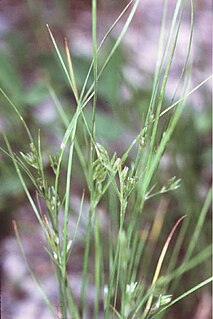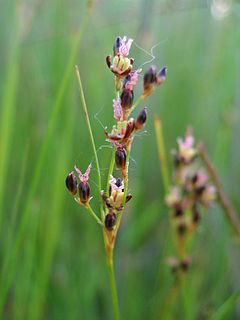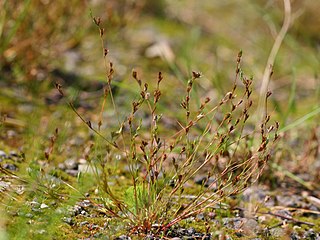
Juncaceae is a family of flowering plants, commonly known as the rush family. It consists of 8 genera and about 464 known species of slow-growing, rhizomatous, herbaceous monocotyledonous plants that may superficially resemble grasses and sedges. They often grow on infertile soils in a wide range of moisture conditions. The best-known and largest genus is Juncus. Most of the Juncus species grow exclusively in wetland habitats. A few rushes, such as Juncus bufonius are annuals, but most are perennials.

Juncus is a genus of monocotyledonous flowering plants, commonly known as rushes. It is the largest genus in the family Juncaceae, containing around 300 species.

Juncus effusus, with the common names common rush or soft rush, is a perennial herbaceous flowering plant species in the rush family Juncaceae. In North America, the common name soft rush also refers to Juncus interior.

Juncus tenuis, the slender rush, is a clump-forming, round-stemmed perennial in the Juncaceae. Slender rush grows to be between 15 and 60 cm tall. Generally considered a weed, it is rarely sold by retailers as a household container plant. Where it is introduced, it is colloquially called path rush, field rush, slender yard rush, poverty rush or wiregrass.

The Eriocaulaceae are a family of monocotyledonous flowering plants in the order Poales, commonly known as the pipewort family. The family is large, with about 1207 known species described in seven genera. They are widely distributed, with the centers of diversity for the group occurring in tropical regions, particularly the Americas. Very few species extend to temperate regions, with only 16 species in the United States, mostly in the southern states from California to Florida, only two species in Canada, and only one species in Europe. They tend to be associated with wet soils, many growing in shallow water. This is also reported from the southern part of India and the regions of Western Ghats hot spots.

Juncus bufonius, known commonly as toad rush, is a widespread flowering plant species complex in the rush family Juncaceae.

Juncus acutus, the spiny rush, sharp rush or sharp-pointed rush, is a flowering plant in the monocot family Juncaceae found throughout the Americas, Northern and Southern Africa, Western and Southern Europe and West Asia.

Juncus articulatus is a flowering plant species in the rush family Juncaceae. It is known by the common name jointleaf rush or jointed rush, which can also refer to J. kraussii from Australia. It is native to Eurasia, Canada, Greenland, and much of the United States. It grows in moist areas, such as wet sand, and thrives in calcareous soils. J. articulatus was found to be more sensitive to drought and salt stress than its congeners J. acutus and J. maritimus. It is a perennial herb producing mainly erect stems from a short rhizome. The stem may root at nodes, and it generally has one or more flattened hollow cylindrical leaves up to 10 centimeters long. Transverse internal partitions or joints may be seen or felt in the leaf of the plant.

In botany and ecology, graminoid refers to a herbaceous plant with a grass-like morphology, i.e. elongated culms with long, blade-like leaves. They are contrasted to forbs, herbaceous plants without grass-like features.
Wesley Martin Knapp is a regional botanist with the North Carolina Natural Heritage Program. Originally from New Hampshire, Knapp is an expert in North American plants belonging to the Cyperaceae (sedges) and Juncaceae (rushes). Knapp has published research in journals including: Systematic Botany, the Botanical Research Institute of Texas, Evansia, and Opuscula Philolicheum.

Juncus balticus is a species of rush known by the common name Baltic rush. It is a perennial flowering plant in the family Juncaceae. This plant can reach a height of about 75 cm. It is native to maritime areas of northern Britain, the Baltic and Scandinavia where it occurs in dune slacks. It is available from specialist nurseries for landscaping and soil stabilization purposes.

Juncus kraussii commonly known as salt marsh rush, sea rush, jointed rush, matting rush or dune slack rush, is of the monocot family Juncaceae and genus Juncus. It grows in salt marshes, estuarine and coastal areas.

Juncus gerardii, commonly known as blackgrass, black needle rush or saltmarsh rush, is a flowering plant in the rush family Juncaceae.

Juncus acutiflorus, also called sharp-flowered rush, is a rush or a grassy plant of the genus Juncus. As the name suggests, the plant has notable sharp-looking flowers, flowering between July and September.

Juncus dichotomus is a monocot which belongs to the Juncaceae family of rushes. The plant is native in the Americas in temperate zones but has been introduced to other parts of the world. The species is often confused with other Juncus plants due to morphological similarity. Juncus dichotomus often is found in areas which prove to be very moist, and rainfall is a common occurrence. Juncus dichotomus is often most recognizable in the spring and summer months of the year due to its conspicuous flowers and infructescence.

Juncus compressus is a species of flowering plant in the rush family, Juncaceae. It is native to temperate Eurasia.Juncus compressus is easy to confuse with J. gerardii.

Juncus ranarius is a species of flowering plant belonging to the rush family Juncaceae.

Juncus validus, the roundhead rush, is a species of flowering plant in the family Juncaceae, native to the central and southeastern United States. It is a somewhat weedy species, found along wet roadsides and in ditches.

Juncus coriaceus, the leathery rush, is a species of flowering plant in the family Juncaceae, native to the southeastern United States, from Texas to Cape May, New Jersey. A report from New York state turns out to have been erroneous. A wetland species, it prefers poorly drained soils.
Juncus sorrentinoi is a species of plant in the family Juncaceae (rushes), with a Mediterranean distribution, and introduced to Madeira. It is listed as Vulnerable by the IUCN.
















